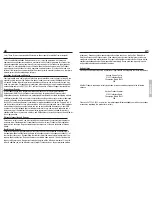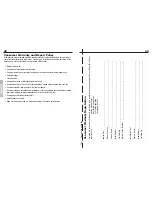
note:
We strongly urge the use of a
tachometer to check rpm readings when
breaking in the engine.
After starting and warming the engine for 30
to 45 seconds adjust as follows. For initial
break-in: do not exceed 4,000 rpm for the first
10 minutes of operation. This allows all the
parts to mate properly with good lubrication.
CaUTiOn:
The engine must be stopped
while you adjust the carburetor in order to
prevent injury by the propeller. Subsequent
runs may be made while slightly leaning out
the mixture with each tank full of fuel. Forty
minutes is considered sufficient time for
normal break-in prior to the first flight.
Introduction to the
Saito Gasoline 4-Stroke
Engines
The Saito four stroke gasoline series of
engines were developed to satisfy a market
need for a more cost effective and cleaner
answer to the then current glow powered
engines. Ever at the forefront of technology,
Saito has led the way many times in
developing engines with large displacements
in small case sizes. It seemed only
natural that Saito would also lead the way to
a more cost effective fuel alternative to glow
powered engines.
Conrods
Saito has developed a specific aluminum alloy
and manufacturing process that allows them
to eliminate the need for a separate bearing
material in the lower end of their conrods.
The benefit of this is you never have to worry
about the bearing material (usually bronze
oilite) rotating in the conrod and blocking off
the critical bearing lubrication holes machined
into the bottom of the conrod. This process
also allows for smaller crankcases and smaller
airplane applications. It also creates the
requirement for the 20:1 oil mixture in our
gasoline powered engines.
Break-in
The most important component to break-in on
all Saito 4-stroke engines, and especially the
gasoline engines is the conrod to crankshaft
interface. The break-in process required for
all Saito engines is designed to break-in the
conrod to crankshaft interface more than to
seat the ring. The ring will seat gradually over
time and the engine will develop more and
more power. The conrod needs to be treated
correctly from the beginning.
Do not skip
this step. You risk seizing the conrod to the
crankshaft.
Understanding the Saito
Gas Carb for the FG-14B
and FG-20
To best understand the FG-14B and FG-20
carburetor you need to know what it is not.
it is not a Walbro carburetor.
it is not a glow carburetor.
This uniquely designed carb came about
because as we made strides to bring cheaper
gasoline power to ever smaller engines, the
currently available carb’s from the lawn power
equipment world were way too large to be
included with our smaller powerplants. We
had tried for years to reduce the weight and
the footprint in each class of engine size and
using the larger lawn power carbs did not
work with our vision.
Gasoline fuel requires a much finer
atomization of the droplets than glow fuel
does. Because the amount of fuel flowing
through the engine is so much lower than
with a typical glow fuel setup (up to 60% less
fuel) maintaining a constant flow and pressure
becomes even more critical. Close inspection
of the cat’s eye orifice on the needle valve
body in the FG-14B/20 carb will reveal a
miniscule opening; perfectly sized for the
proper atomization of the fuel for your engine.
This new carb features a pump function
designed to provide the correct amount of fuel
to the needle valve assemblies to correctly
operate the engines. It is not designed as a
fuel pump to draw fuel from a tank mounted
in the middle of your airplane. The fuel tank
needs to be mounted as close to the centerline
of the Carb assembly as possible; the same as
we have had to do for all these years with our
glow engine installations. If you stray very far
from this rule the engine will run differently
upright and inverted. This usually leads to
comments that an engine doesn’t like to run
inverted, etc when in reality the fuel delivery
system needs to be optimized for the engine
installation being used.
The pump is actuated by the negative
pressure pulses when the intake valves are
open and the engine is drawing fuel into
the cylinder. On the latest version of the
carburetor we have enlarged the area of the
hole that delivers these pulses to the pump
assembly and it has greatly improved the
pumping action and has much more tolerance
of ‘less than optimum’ fuel tank locations. But
it is still not a Walbro carb and will not draw
fuel from any long distance.
12
F G - 1 4 B / F G - 2 0 I N T R O D U C T I O N T O 4 - S T R O K E E N G I N E S
F G - 1 4 B / F G - 2 0 U N D E R S T A D I N G T H E S A I T O G A S C A R B U R E T O R
13








































